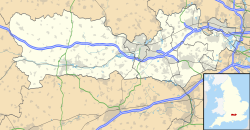Windsor Castle
| Windsor Castle | |
|---|---|
| Windsor, Berkshire in England | |

Viewed from the Long Walk
|
|
|
Location within Berkshire
|
|
| Coordinates | 51°29′0″N 000°36′15″W / 51.48333°N 0.60417°WCoordinates: 51°29′0″N 000°36′15″W / 51.48333°N 0.60417°W |
| Type | Three bailey wards with a round keep |
| Site information | |
| Owner | Queen Elizabeth II in right of the Crown |
| Operator | Royal Household |
| Open to the public |
Limited access |
| Site history | |
| In use | Late 11th century – present |
| Materials | Bagshot Heath stone |
| Events | First Barons' War, English Civil War |
Windsor Castle is a royal residence at Windsor in the English county of Berkshire. It is notable for its long association with the English and later British royal family and for its architecture. The original castle was built in the 11th century after the Norman invasion of England by William the Conqueror. Since the time of Henry I, it has been used by the reigning monarch and is the longest-occupied palace in Europe. The castle's lavish early 19th-century State Apartments were described by the art historian Hugh Roberts as "a superb and unrivalled sequence of rooms widely regarded as the finest and most complete expression of later Georgian taste". Inside the castle walls is the 15th-century St George's Chapel, considered by the historian John Martin Robinson to be "one of the supreme achievements of English Perpendicular Gothic" design.
Originally designed to protect Norman dominance around the outskirts of London and oversee a strategically important part of the River Thames, Windsor Castle was built as a motte-and-bailey, with three wards surrounding a central mound. Gradually replaced with stone fortifications, the castle withstood a prolonged siege during the First Barons' War at the start of the 13th century. Henry III built a luxurious royal palace within the castle during the middle of the century, and Edward III went further, rebuilding the palace to make an even grander set of buildings in what would become "the most expensive secular building project of the entire Middle Ages in England". Edward's core design lasted through the Tudor period, during which Henry VIII and Elizabeth I made increasing use of the castle as a royal court and centre for diplomatic entertainment.
...
Wikipedia

